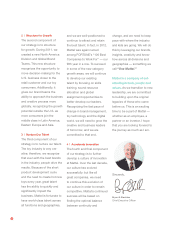Mattel 2011 Annual Report Download - page 19
Download and view the complete annual report
Please find page 19 of the 2011 Mattel annual report below. You can navigate through the pages in the report by either clicking on the pages listed below, or by using the keyword search tool below to find specific information within the annual report.their inventories, Mattel experiences cyclical ordering patterns for products and product lines that may cause its
sales to vary significantly from period to period.
In anticipation of retail sales in the traditional holiday season, Mattel significantly increases its production
in advance of the peak selling period, resulting in a corresponding build-up of inventory levels in the first three
quarters of its fiscal year. Seasonal shipping patterns result in significant peaks in the third and fourth quarters in
the respective levels of inventories and accounts receivable, which result in seasonal working capital financing
requirements. See Item 8 “Financial Statements and Supplementary Data—Note 7 to the Consolidated Financial
Statements—Seasonal Financing and Debt.”
Product Design and Development
Through its product design and development group, Mattel regularly refreshes, redesigns, and extends
existing toy product lines and develops innovative new toy product lines for all segments. Mattel believes its
success is dependent on its ability to continue this activity effectively. See Item 1A “Risk Factors—Factors That
May Affect Future Results.” Product design and development activities are principally conducted by a group of
professional designers and engineers employed by Mattel. During 2011, 2010, and 2009, Mattel incurred
expenses of $179.0 million, $173.9 million, and $171.3 million, respectively, in connection with the design and
development of products, exclusive of royalty payments. See Item 8 “Financial Statements and Supplementary
Data—Note 15 to the Consolidated Financial Statements—Supplemental Financial Information.”
Additionally, independent toy designers and developers bring concepts and products to Mattel and are
generally paid a royalty on the net selling price of products licensed to Mattel. These independent toy designers
may also create different products for other toy companies.
Advertising and Marketing
Mattel supports its product lines with extensive advertising and consumer promotions. Advertising takes
place at varying levels throughout the year and peaks during the traditional holiday season. Advertising includes
television and radio commercials, magazine, newspaper, and internet advertisements, and social media.
Promotions include in-store displays, sweepstakes, merchandising materials, and major events focusing on
products and tie-ins with various consumer products companies.
During 2011, 2010, and 2009, Mattel incurred expenses of $699.2 million (11.2% of net sales), $647.3
million (11.1% of net sales), and $609.8 million (11.2% of net sales), respectively, for advertising and
promotion.
Sales
Mattel’s products are sold throughout the world. Products within the Domestic segment are sold directly to
retailers, including discount and free-standing toy stores, chain stores, department stores, other retail outlets, and,
to a limited extent, wholesalers by Mattel Girls & Boys Brands US and Fisher-Price Brands US. Mattel also
operates several small retail outlets, generally near or at its corporate headquarters and distribution centers as a
service to its employees and as an outlet for its products. American Girl Brands products are sold directly to
consumers and its children’s publications are also sold to certain retailers. Mattel has eleven retail stores,
American Girl Place®in Chicago, Illinois, New York, New York, and Los Angeles, California, and
American Girl®stores in Alpharetta, Georgia, Dallas, Texas, Natick, Massachusetts, Bloomington, Minnesota,
Lone Tree, Colorado, Overland Park, Kansas, McLean, Virginia, and Lynnwood, Washington, each of which
features children’s products from the American Girl Brands segment. American Girl Brands also has a retail
outlet in Oshkosh, Wisconsin that serves as an outlet for its products. Products within the International segment
are sold directly to retailers and wholesalers in most European, Latin American, and Asian countries, and in
Australia, Canada, and New Zealand, and through agents and distributors in those countries where Mattel has no
direct presence. Mattel also has retail outlets in Latin America and Europe that serve as outlets for its products.
Additionally, Mattel sells certain of its products online through its website.
7
























